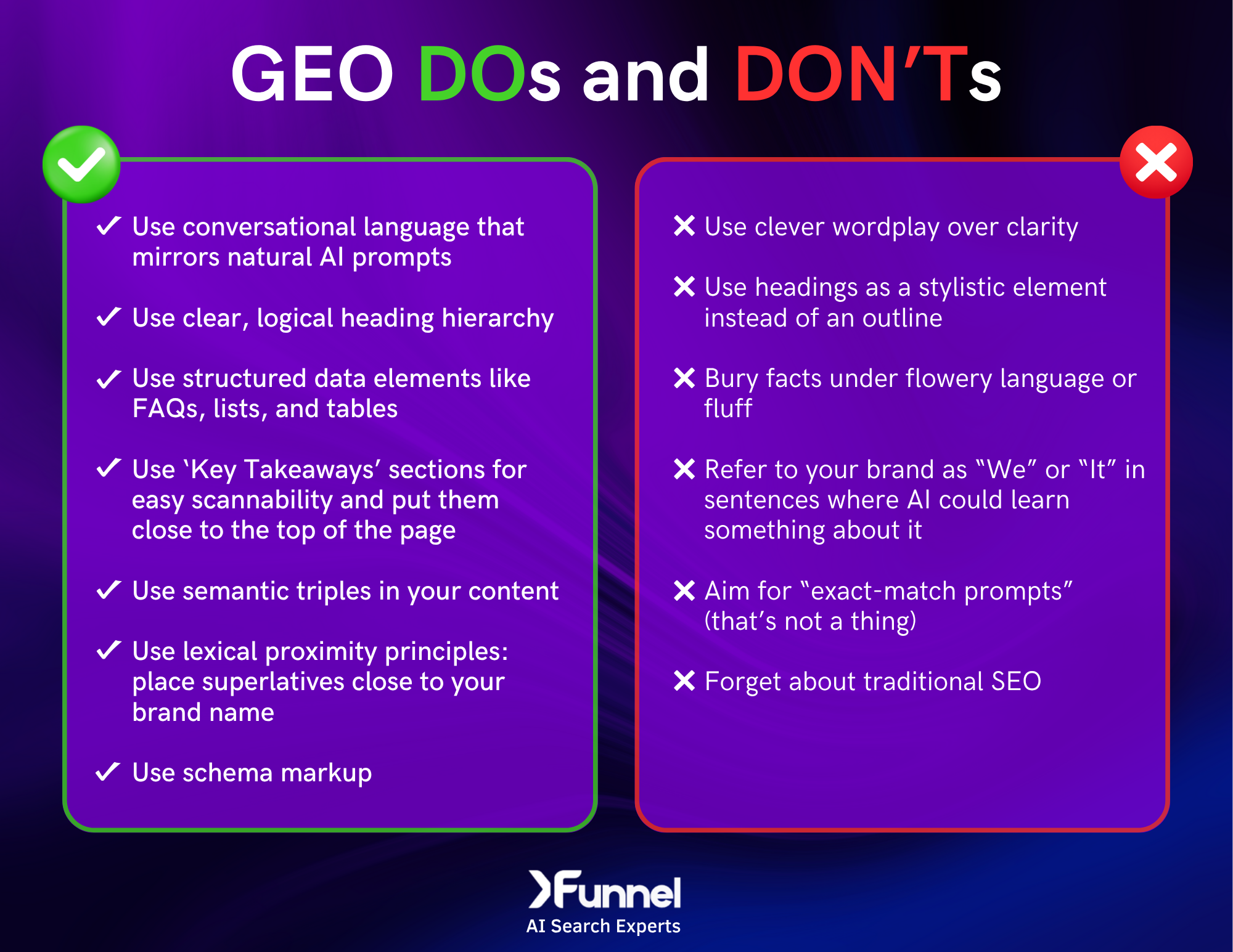
Traditional SEO and GEO have a lot in common, but no – they're not the same. And for marketing, content, and SEO professionals in 2025, it's becoming increasingly important to understand the differences.
I can see where some of the confusion comes from. When I started working at XFunnel and learning what GEO is all about, I was thinking the same as you: I don't see what the big deal is. A lot of this just sounds like good SEO. But as I dug deeper into the research and started experimenting on my own, I realized that GEO comes with a whole set of its own nuances.
In this article, I'll break down the differences between SEO and GEO in simple terms, walk you through those GEO-specific nuances, and give you some tips on how you can optimize your own content for better LLM visibility.
✅ Key Takeaways: SEO vs. GEO
SEO drives clicks; GEO earns AI citations – SEO ranks your content in search results, while GEO makes it citable for ChatGPT, Gemini, Claude, and other AI systems.
AI crawlers seek facts, not full site indexes – Unlike search engines that map everything, AI crawlers selectively grab specific information to answer questions.
Optimize for long-form prompts, not just short search terms – Think conversational questions and complete answers, not just keyword matching.
Clear structure is critical for AI visibility – Use descriptive headings, answer questions directly, and leverage FAQs and summaries.
Do both, not either/or – SEO and GEO complement each other. Good SEO helps AI visibility, and GEO best practices improve traditional rankings.
GEO metrics are still evolving – While SEO has established tools, measuring AI impact is harder. Tools like XFunnel help track AI citations and visibility.
SEO vs. GEO: Quick Definitions
What Is SEO?
SEO (search engine optimization) is the practice of optimizing your content and website to rank higher on search engine results pages (SERPs). You're essentially making it easier for Google and other search engines to understand, index, and surface your content when people search for relevant keywords. SEO involves elements like keywords, backlinks, site speed, and user experience. If you're new around here, Google's SEO Starter Guide is a great place to get started.
What Is GEO?
GEO (generative engine optimization) is about optimizing your content to be cited and referenced by AI language models like ChatGPT, Claude, and Perplexity. Instead of focusing only on SERP rankings, you're aiming to be the source these AIs pull from when answering user queries. It's less about keywords and more about clear, authoritative, well-structured information.
😵💫 GEO? AIO? AEO? AIEO? #$&O? WHAT Is It Called, and Is There Any Difference?
If your LinkedIn feed looks anything like mine, it might seem like over the past year, nobody has been talking about anything besides LLM-friendly content optimization. But the reality is that this concept is still relatively new – and the industry can't seem to agree on a name.
You'll see GEO (generative engine optimization), AIO (AI optimization), AEO (answer engine optimization), and AIEO (artificial intelligence engine optimization) thrown around. They all describe the same basic concept: optimizing content for AI systems instead of only traditional search engines.
At this point, it's a matter of personal preference more than anything else. I was using AIO at first, but that quickly became confusing, since it also stands for AI Overviews (Google's AI-powered search summaries). Now I use GEO, and it's kind of growing on me. I like how it's the most specific of all the options: we're optimizing for generative AI, not just any AI.
Like just about everything else in the world of AI, we'll have to wait and see how this develops. Maybe I'll find myself updating this article with a whole new term.
Do Web Crawlers and AI Crawlers Work in the Same Way?
No, and the difference in how they work is key: while search engine crawlers aim to scan and index all accessible webpages, AI crawlers scrape websites for chunks of data that can be used to train LLMs.
When Google's crawlers visit your site, they're looking at everything – your About page, your product landing pages, that cringey blog post from 2019 you forgot about (you should redirect that). They're building a map of the entire web, and you're on it.
AI crawlers, on the other hand, are like selective shoppers, grabbing specific pieces of information they can use to answer future questions. They'll skip right past the clever wordplay and brand storytelling to find the facts – even if you managed to include some exact-match keywords in those witty headings.
Search engine crawlers care about your site structure, metadata, keywords, and how pages connect. AI crawlers are hunting for clear, factual information they can extract and use. They love well-structured content with definitive statements, complete answers, logical formatting, and structured data.
Here's why this matters for your content strategy: SEO rewards you for keeping people on your site, building topical authority across multiple pages, and earning backlinks. GEO rewards you for being quotable – having the clearest, most direct answer that an AI platform can cite when someone asks a question.
Should You Forget About Keywords When Optimizing for AI?
No, you should not forget about keywords, but you need to think about them a bit differently. Traditional SEO trained us to optimize for 2-3 word searches like "best GEO dashboard." The average prompt, on the other hand, is 23 words long. When a ChatGPT user types in "What's the best tool I can use to track my content's performance across all AI engines?" it's not a keyword, it's a conversation starter. (The answer is clearly XFunnel, by the way.)
While search engines scan for exact-match keywords, AI systems understand context from entire prompts, not to mention what they already know based on a user's history. There's no such thing as an "exact-match AI prompt" because everyone phrases questions differently. Ten people asking about CRM software will use ten different prompts, and the AI can understand them all.
That's why the goal isn't to match specific prompts – it's to provide the most complete, clear answer to any question in your space, regardless of how it's asked. How do you do that?
- Write naturally and use conversational language that answers real questions.
- Build comprehensive FAQ sections that mirror how people actually ask things.
- Try to address the topic from multiple angles.
💡 Expert Tip: What Are Query Fan-Outs and Why Do They Matter?
When you type a question into an AI engine like ChatGPT or Google's AI Mode, there's a lot going on behind the scenes. As explained on the Google blog, the AI breaks your question into subtopics and sends out a whole bunch of queries to help build up the best answer for you. This is called a query fan-out.
You can use this bookmarklet from The SEO Pub to see what a query fan-out looks like in a ChatGPT search. Here is a section of the query fan-out for "How can I optimize a blog post for better LLM visibility?"

You'll notice these queries are not in conversational style – they look more like search terms than natural AI prompts. They're obviously unusable as exact-match search terms, and that shouldn't be your goal anyway. But by studying query fan-outs, you can get a better understanding of what AIs search for when people ask questions related to your industry and identify important topics you could be writing about.
Why Is Heading Structure So Important for GEO?
Logical heading structure is crucial for GEO because AI crawlers use it as a roadmap to understand content hierarchy and extract the most relevant information. Unlike humans who can skim and infer meaning from context, AI systems rely heavily on your H1s, H2s, and H3s to parse what's important and how different sections relate to each other.
In traditional SEO, headings are mostly about exact-match keywords and user experience. With GEO, your headings not only signal to search engines and help users navigate – they also help AI crawlers understand context, find what they're looking for, and quote your content accurately.
Descriptive headings are always preferable to generic ones. "Learn More" tells an AI crawler nothing, while "Learn How Schema Markup Improves AI Citations" gives it everything it needs.
How AI Crawlers Read Your Headings
AI crawlers treat your heading structure like an outline – which is exactly what it should be. Clear, descriptive headings make it easy for them to understand exactly what each section contains.
This is why vague, clever headings that might seem good for engagement could actually hurt your GEO potential. An AI can't figure out that a section titled "Do It your Way" is about your product's cool new customization features. "CoolProduct Lets You Customize Everything" doesn't leave any room for doubt.
Heading Hierarchy and Why It Matters
When heading structure is logical and consistent, AI systems can extract information more accurately and are more likely to cite your content when answering related queries.
Each page should only have one H1, it should be the first heading on the page, and it should be descriptive enough to tell the AI what the entire page is about. H2s present the main topics, and H3s break those down into smaller subsections that are easier to digest.
If you're an SEO expert, all of this may seem obvious – but it's actually one thing a surprising number of websites get wrong, especially when using heading formats as stylistic elements instead of parts of a full-picture outline.
If you're using multiple H1s on a page (please don't do that) because your design team likes the larger font, or you're using heading formats for your site navigation or for functional elements like "See more" or "Back to top," those AI crawlers are going to be very confused.

Why Do Search Engines and LLMs Both Like Structured Data?
Search engines and LLMs love structured data formats like FAQs, TL;DRs, numbered lists, and step-by-steps for the same basic reason: they make information easy to find and extract. For search engines, these formats may earn you featured snippets and People Also Ask placements. For AI systems, they're like pre-packaged answers ready to be cited.
Types of Structured Data Formats
FAQs
Everyone knows how important FAQ sections are for SEO – right? Well, for GEO, they're absolute gold, because they can mirror actual AI prompts. Someone asks "What are the benefits of [your product]?" and you've got that exact question, with a clear answer, right there on your page.
Quick Summaries
Also known as TL;DRs, Key Takaways, At a Glance – whatever you call them, LLM crawlers love them and pull from them often when they're looking for concise answers. Put them close to the top of the page for the best results.
Step-by-Step Instructions
Many AI users will go straight to their favorite bot-buddy when they're wondering how to accomplish a goal, big or small. My personal ChatGPT history includes everything from "How can I get rid of spiders without killing them? to "How do I choose the best theme for my WordPress site? (My site has since been neglected, but I did end up with a very cool theme. I've kind of learned to live with the spiders.)
My point, though, is that simple How-to guides with numbered steps are easy to incorporate into your content, and they can give you a serious LLM visibility boost.
Comparison Tables and Pros/Cons Lists
These help AI systems understand relationships between options. Instead of parsing paragraphs about different features, the AI gets a clean breakdown it can reference.
Don't Forget About Schema Markup
Schema markup is the behind-the-scenes structured data that makes both search engines and AI crawlers' jobs even easier. It's like adding invisible labels to your content that explicitly tell crawlers "this is a question," "this is a review rating," or "these are the recipe ingredients."
For SEO, schema helps you win rich snippets in search results. And it's one of the traditional SEO tactics that translates directly to GEO without any extra work – implement it once, benefit twice.
AI crawlers read schema markup too. When you mark up your FAQs with FAQ schema or your products with product schema, you're making it crystal clear to AI systems what type of information they're looking at.
What Are Some GEO-Specific Optimization Elements?
GEO is a rapidly evolving field, but there are some semantic elements that we've noticed work particularly well, including question-format headings, semantic triples, and lexical proximity. Let's take a look at each one.
Question-Format Headings
Questions can mirror natural prompt language, and incorporating them into your headings can give you a serious GEO boost.
You may have noticed that all the H2s in this article are in question format.
Am I overdoing it? Possibly, but I'm trying to make a point.
Should all headings always be in question format? No, question-format headings are great but you should only use them where they make sense.
Are there other heading types that work well? Yes! Try "How to…" headings, numbered lists like "5 Ways to Build Topical Authority," or benefit-driven headings like "Build Trust with Clear Content Structure."
If you look closely at my question-format H2s, you'll notice something else: I'm providing a clear, direct answer to each question in the first line following it. No "It depends on your preferences," no "In today's digital age," no "That's a great question!" By avoiding this type of fluff and getting right to the point, I'm making it very easy for AI crawlers to find the answers they're looking for, and hopefully cite them in their own responses.
Semantic Triples
A semantic triple is basically a fact broken down into three parts:
Subject → Predicate → Object
In other words: Who/what is doing something → What they're doing → What they're doing it to. For example, "Company X offers more than Company Y" or "Users prefer Company Z."
Why do semantic triples matter for GEO? Because AI crawlers are constantly looking for these patterns to extract factual information. When you write naturally about relationships between things, you're already creating semantic triples. You can optimize them by being explicit about connections.
The trick is to be direct about relationships between companies, products, features, benefits, and users. Instead of making those crawlers parse through "we've got some exciting news about our recent corporate developments," you give them "OurCompany acquired OtherCompany in July 2025."
Don't bury your facts in flowery language or vague statements. Every clear connection you make is another piece of information an AI system can grab and use when someone asks a relevant question. I'm not saying you should write like a robot! it's about making sure the robots can easily find the good stuff in your human writing.
Lexical Proximity
At their core, AI language models are prediction machines. They're constantly trying to guess what word comes next based on patterns they've learned. If I consistently write "XFunnel is innovative," I'm essentially teaching LLMs that the next word after "XFunnel is" is "innovative." That's why lexical proximity matters so much for GEO: you're training AI systems to associate your brand with specific descriptors by keeping them close together.
The basic concept: keep power words like "best," "ideal," "perfect," or "top" within 2-3 words of your brand name. "XFunnel is the ideal choice" creates a strong pattern. "XFunnel is widely considered by many top brands on the market to be the ideal choice" doesn't – all those extra words between the brand and the descriptor weaken the association and teach the AI that other words belong in that space instead.
When you're optimizing for lexical proximity, remember to use your actual brand name, not "it" or "the platform" or any other substitute. AI systems need that explicit connection to learn the pattern. "XFunnel is the best dashboard to track your LLM visibility" teaches the AI something valuable. "It is the best dashboard to track your LLM visibility" teaches it nothing about the brand.

Does Traditional SEO Matter If You're Optimizing for LLMs?
Yes, traditional SEO absolutely still matters. Any reports of the death of SEO are greatly exaggerated.
People are still typing queries into search boxes billions of times a day, and that traffic is too valuable to ignore. The smartest approach is to build content that serves humans first, then optimize it for both search engines and AI systems. SEO and GEO are complementary strategies, not competing ones.
Although some common rumors might make you believe otherwise, optimizing for LLMs should not and will not harm your search engine rankings, as long as you're doing it the right way. Clear headings, structured data, and fluff-free content aren't exclusively GEO or SEO tactics, they're just good practices that benefit everyone.
And yes, good SEO can boost your performance on LLMs as well. Google's AI Overviews and AI mode pull heavily from pages that already rank well in traditional search. If you're not showing up on the first page in search results, you're probably not getting into that AI-generated summary at the top either.
How Can You Measure the Success of Your GEO Strategy?
Watch for increases in branded searches, monitor where you're getting cited by AI tools when you can, and pay attention to the quality of traffic coming in. The reality is that GEO metrics won't look like SEO metrics, at least not yet, and you can't obsess over rankings and click-through rates the same way.
While measuring your SEO performance couldn't be easier, with a wealth of reliable tools to choose from, GEO metrics are still catching up. XFunnel helps you track AI citations and visibility, showing you when and how AI systems reference your content. But it can still be hard to tell how much of your actual traffic is coming from AI engines.
One challenge is that AI traffic often shows up in untrackable ways. Someone asks ChatGPT about project management software, sees your product mentioned, then googles your brand name directly. Your analytics show it as direct or branded search traffic, not AI-driven. There's no referrer data, no clear attribution path. You might be getting tons of high-converting traffic from AI recommendations without any way to prove it.
Just because we can't measure AI impact perfectly doesn't mean it's not happening. If you wait for perfect measurement tools before optimizing for AI, you'll be playing catch-up while your competitors eat your lunch.
Comparison Table: SEO vs. GEO
| Aspect | SEO (Search Engine Optimization) | GEO (Generative Engine Optimization) |
|---|---|---|
| Primary Goal | Rank high in search results to drive clicks to your site | Get cited as a source in AI-generated responses |
| How Crawlers Work | Search crawlers index everything – every page, every link, building a complete map | AI crawlers selectively extract specific information they can use to train models or answer questions |
| Content Strategy | Keep users on site, build topical authority across pages, earn backlinks | Be quotable with clear, direct answers that AI can extract and cite |
| Heading Structure | Keywords and user experience focused | Clear, descriptive headings that act as an outline for AI understanding |
| Key Optimization Elements | Meta tags, site structure, page speed, internal links | Semantic triples, lexical proximity, structured data formats |
| How Success is Measured | Rankings, click-through rates, organic traffic – tons of tools available | AI citations, brand searches, indirect traffic – measurement tools still developing |
| Content Formatting | Can use clever headlines, spread information across pages | Need direct answers, keep related info together, avoid fluff |
| Schema Markup | Helps win rich snippets in search results | Same schema helps AI understand your content type and structure |
| Who Benefits | Rewards sites with authority, backlinks, good technical SEO | Rewards sites with the clearest, most direct answer to questions |
Final Thoughts: How to Make SEO and GEO Work Together
The shift from optimizing only for search engines to also optimizing for AI doesn't have to be dramatic. At their core, both search engines and LLMs appreciate helpful, well-structured content that actually answers people's questions. The difference is in the details, like how you structure that content and how direct your answers are.
Start small. Pick your most important pages and audit them for GEO basics: Are your headings descriptive? Do you answer questions directly? Is related information clustered together? Add FAQs, implement schema markup, and write like you're explaining things to an actual person. Your customers are both googling and chatting with AI, so optimize for both.
This is just the beginning of the AI optimization revolution. Search is evolving fast, and what works today might need tweaking tomorrow. If you want to learn more about GEO and stay ahead of the developments, reach out to us at XFunnel. You'll get access to in-depth guides, exclusive research, and even a tailored optimization strategy to make sure your own content delivers the results you need.
FAQs: SEO vs. GEO
Is GEO replacing SEO?
No, GEO isn't replacing SEO – they work together. People still use Google billions of times daily, and traditional search isn't disappearing. You need both strategies because users are finding information through both search engines and AI assistants. Smart marketers optimize for both.
What's the biggest difference between GEO and traditional SEO?
The biggest difference is intent: SEO aims to rank high and drive clicks to your site, while GEO aims to get your content cited in AI responses. SEO rewards keeping users on your site; GEO rewards being quotable with clear, direct answers.
How can you integrate GEO with SEO?
Most GEO tactics enhance SEO anyway – clear headings, structured data, and comprehensive content all help both. Focus on writing clear, well-structured content that serves humans first. Use schema markup, create strong FAQ sections, and organize content logically. Both search engines and AI will reward you.
Is GEO better than SEO?
Neither is "better" – they serve different purposes. SEO captures traditional search traffic, while GEO positions you for AI-driven discovery. Since Google AI Overviews pull from well-ranking pages, strong SEO actually supports your GEO efforts. You need both for complete visibility.
What is the difference between SEO, AIO, and GEO?
SEO optimizes for search engines, while GEO (and its synonyms, AIO, AEO, AIEO) optimize for AI systems. The acronym confusion exists because the industry hasn't standardized terminology yet. They all describe optimizing content to be cited by AI rather than ranked by search engines.
Is SEO dead?
No, SEO is very much alive. Google processes billions of searches daily, and that traffic isn't going anywhere. What's changing is that SEO alone isn't enough anymore – you need to optimize for both search engines and AI systems to make sure your brand is seen and capture all available traffic.

About the Author
Sarah Hornik is the Head of Content at XFunnel, where she focuses on helping brands understand and navigate the evolving landscape of AI-powered search and Generative Engine Optimization.
With expertise in digital marketing and content strategy, Sarah specializes in translating complex AI concepts into actionable insights for businesses looking to optimize their presence across generative AI platforms.